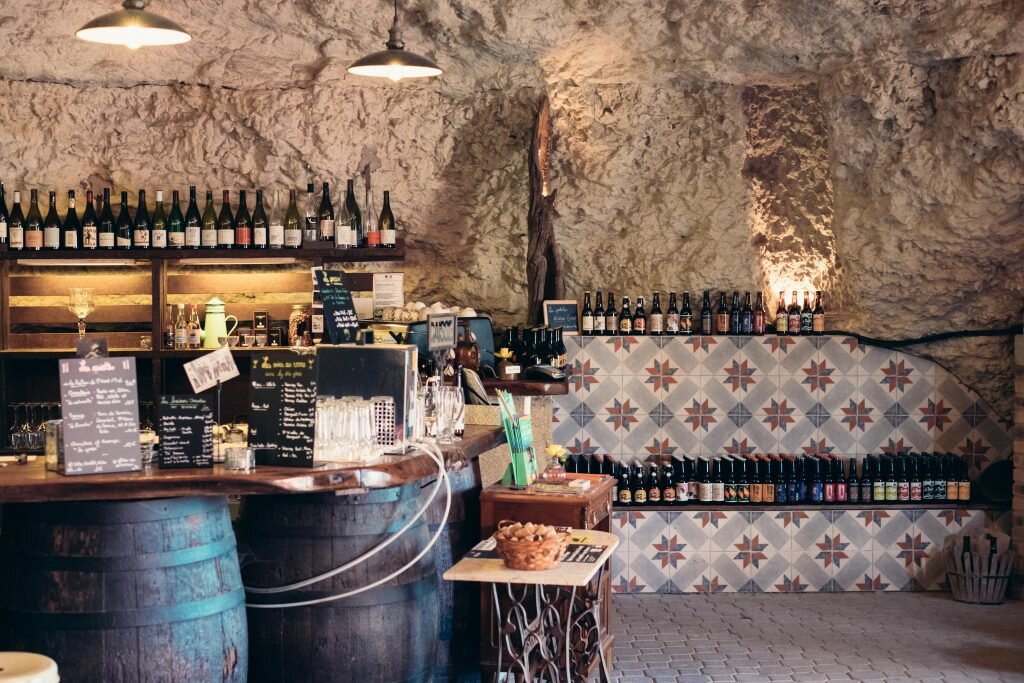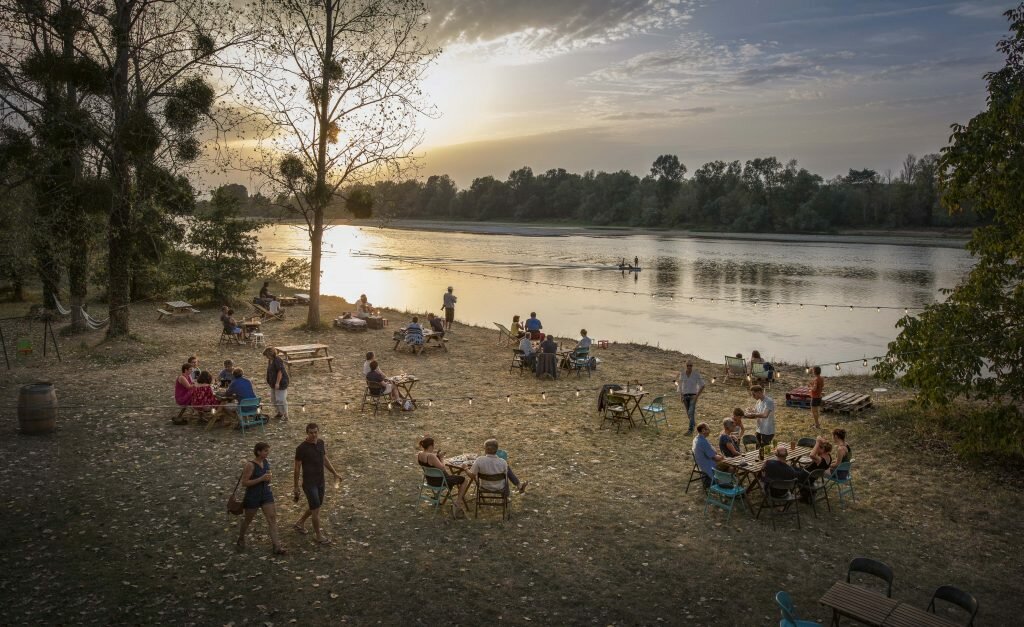On the banks of the River Loire, midway between the cities of Tours and Blois, wine bistro Volupia combines two old, incongruous French traditions: troglodyte cave living and guinguette outdoor summer tavern escapism.
On one side of the road, sunk deep into a white cliff, the wine bistro cave’s dark maw of an entrance seems uninviting, but the cosy, string light-crisscrossed interior — decorated with old Air France posters, saddle-tan armchairs and antique dressers displaying retro glass lamps and teapots — is a far cry from what the cave’s prehistoric occupants would have done with the place.
Crossing the street, I emerge into a hidden, festive riverbank beach bar, where plates of smoked catfish crostini, Normandy oysters and blood sausage are being ferried from a street-art-covered caravan to red-gingham clothed picnic tables while hip 20- and 30-somethings play petanque in the sun.
The property, owned by the same family since 1643, was previously a small cellar where the owner sold 10 local wines to passersby. When millennial couple Marlene Bouron and Valentin Gasnier quietly opened Volupia, named after the Roman goddess of sensual pleasure, here in 2016, it quickly became the go-to local hangout.
“We took over in order to sell wine from the Loire and also had the idea to be a bar and do some small plates of food. Now, we are more wine and beer bar than a cave,” says Bouron, now 29, as she delivers a glass of Brasserie des Fontaines’ La Fosse Blonde beer to my table.
Encompassing cities and towns such as Orleans, Bourges, Blois, Nantes, Tours and Angers, and some 800 square kilometres of countryside in the middle of the country, including the 280km UNESCO-listed stretch from Chalonnes-sur-Loire to Sully-sur-Loire, the Loire Valley has been conferred the poetic title of Garden of France for its abundant organic vineyards, fruit orchards and farms.
While Volupia may be the new hotspot, it’s an indoor-outdoor culinary experience underscored by tradition. Troglodyte caves in the region have been used by local merchants and vignerons as storage for their wares for centuries. Unused until now, the grassy riverbank space is perfect for a modern take on the historic guinguettes, bucolic summer escapes where 18th century factory workers would go to eat, drink and make merry on their days off.
Bouron and Gasnier also do a brisk trade in old, local specialities. Daily specials might include desserts made with poire tapees, a centuries-old sweet treat of pounded, baked and preserved pears from the rehydrated wine of Vouvray AOP; or home-made tarte tatin, an upside down apple tart said to have been invented in the 19th century during a kitchen mishap at Hotel Tatin, 90 minutes’ drive up the road in Lamotte-Beuvron.
Some delights have even longer pedigrees: rillettes de Tours, the savoury, shredded slivers of golden slow-cooked pork with a feathery texture, date back to the 15th century and have been immortalised in the works of Rabelais, Balzac and Proust.
Served as a starter or main with salad and crusty bread, it’s the type of dish likely served at the raft of Renaissance-themed balls and dinner events sweeping Loire Valley chateaux as they celebrate the 500th anniversary of the Renaissance this year, precipitated by the 1519 death of Leonardo Da Vinci and birth of Catherine de Medici, both former residents of the region.
“The Black Queen”, as de Medici is remembered, particularly, has exerted a lasting influence on local dining traditions. When she arrived in France from Florence to wed King Henry II, she introduced exotic fashion and culinary flair to her adoptive country. Lavish parties and refined dinners were regular fixtures at her Venetian palace-inspired home Chateau de Chenonceau, where she built a famed monochrome-tiled entertaining gallery spanning the river. Today, the castle’s fine dining restaurant L’Orangerie, helmed by Touronian chef Christophe Canati, maintains those traditions, making it a popular destination for Paris Fashion Week’s front row, who arrive via helicopter to indulge in the Royal Pleasures menu of dishes — marbled foie gras with smoked eel and green apple, Iranian black lemon scented crab meat with velouté and petits pois — and heavenly desserts du jour.
I order Canati’s decadent citrus pastry crowned with violets, created especially for de Medici’s birthday. Surrounded by well-heeled aesthetes and showstopping blooms by Chenonceau’s Meilleur Ouvrier de France-winning florist Jean Francois Boucher in the airy white dining room, I feel like I’m at a gala thrown by a member of France’s aristocracy. I later learn my sentiment isn’t far off: the property is privately-owned and maintained — including period furnishings and an extensive art collection which includes works by Mino da Fiesole and Caravaggio — by the wealthy matriarch of the Menier chocolatier family.
An hour’s drive northwest, Chateau de Chambord is easily as striking as Chenonceau, except it has none of the creature comforts. It was completed by Francois I in 1547 but as the contemporary French court was nomadic and moved its furnishings from castle to castle, the King only spent a few weeks here over the course of his reign and its imposing stone halls and living quarters remain eerily empty. But Relais de Chambord, a sleek modern hotel on the grounds, has the travelling gourmand’s back. Its cosy French-clubstyle bar offers fireside drinks, billiards and rustic dishes, such as a truffled ham and Comté cheese croque-monsieur and hot goat cheese salad ostentaciously crowned with rich slabs of fried crottin de Chavignol; in the evening, I attend a more formal dinner at Michelin-recognised Grand Saint Michel restaurant, where dishes like wing of skate, served Grenobloise style, and caviar from Sologne with a kombu seaweed reflect the seasons of the surrounding terroir.
The Loire is also home to another category of chateau — the winemaking variety. With a bewildering 4,000 producers scattered across a region of more than 100 AOC (Appellation d’origine Controlee) and IGP (Indication Geographique Protegee), it can be hard to know where to start. Vins du Val de Loire is a treasure trove of information and the website features an interactive map detailing the best routes to explore by car, by bike, on foot or by sailing the river in a toue, a traditional fisherman’s boat, although there’s a lot to be said for driving through the region’s village of white tuffeau limestone homes, cathedrals and fairytale palaces and stopping whenever you feel thirsty.
The Loire’s crisp, dry whites are the show stealers and Sauvignon Blanc lovers could spend weeks exploring the zippy, citrus-forward productions of Sancerre, which rank among some of the world’s most lauded.
Domaine Gerard Boulay, run by a family who has lived here since the 1300s, crafts nuanced, strongly mineral wines comparable in style to complex white Burgundy; at Domaine Henri Bourgeois, sample its fl eshy Le MD de Bourgeois, either during a picnic among the vines on-property or at the family’s Michelin-recognised bistro La Cote des Monts Damnes, nearby.
The Pouilly-sur-Loire AOP is singularly devoted to white wines made primarily with the esoteric Chasselas grape (often blended with a hint of Sauvignon Blanc) and you’ll find well-rounded, dry chenin blanc, Anjou and Vouvray elsewhere. Sancerre’s easy drinking pinot noir is also worth sampling for its bright acidity and plum and cherry aromas; Bourgueil and Saumur-Champigny wines, made using Cabernet Franc grapes, will satisfy fans of textural reds.

Some of the Loire’s best cellars are found in the towns, deep in the bowels of historic hotels and restaurants. At Hotel Grand Monarque in Chartres — oddly named given that it dates from 1791, the first year of the French Revolution, when nobles were literally losing their heads — I descend a series of roughly hewn stone steps with fifth-generation proprietor CEO Bertrand Jallerat for a pre-dinner tipple in the hotel’s lauded wine cellar.
Named after the prolific French writer and wine lover Jean Carmet, its tightly curated 2000 selections won Best Wine List in France for 2019 from the Marie Claire group, and while the highest shelves here house dusty bottles from 1924 and €16,000 ($24,229) bottles of Domaine de la Romanée-Conti, we opt for something more modest: Bel Air chenin blanc to enjoy with a speciality Chartres meat pie, a pate en croute made with foie gras, truffles, cognac and spices. Like most epicurean delights of Loire Valley, the Chartres pie has a unique story — and its own brotherhood, which holds its chapter meeting in town every October.
“A craftsman and his former student each made rival versions of pate three centuries ago and had a well-known poet write about the pies they made with it. This pie is still famous,” says Jallerat, as he proffers a slice with some pickled cornichon and a local goat cheese.
Ah, chevre. France is the world’s top producer of pure goat’s cheese, with 14 out of 45 styles given the PDO (Product Designation of Origin) label, which ensures the cheese has been made in a strictly designated geographical area, using only local milk and traditional production techniques.
Five of these are made in the Loire Valley, and any visiting turophile should endeavour to sample every last one — particularly Sainte-Maure de Touraine, shaped like a small log with a rye straw running horizontally through it — as well as the region’s incredible cow’s cheese. My greatest seducer: Curé Nantais, a creamy raw cow’s milk cheese with an eye-catching orange rind washed with Muscadet wine from Saint-Julien de Concelles.
As I climb the stone stairs to the lobby, I reflect on how it’s hard to dine poorly in the Loire. Every town and village has its own speciality bakeries, creperies, butchers and bistros. The Michelin map is liberally peppered with starred restaurants — from 19th century mansion L’Atlantide 1874 in Nantes to the Grand Monarque’s in-house restaurant Le Georges (named after Jallerat’s great grandfather), whose walls are decorated with antique ovens as a tribute to his love for cooking.
In the Loire, food is a way of life, and every moment offers something to savour.
This story first appeared in the October 2019 issue of A.














